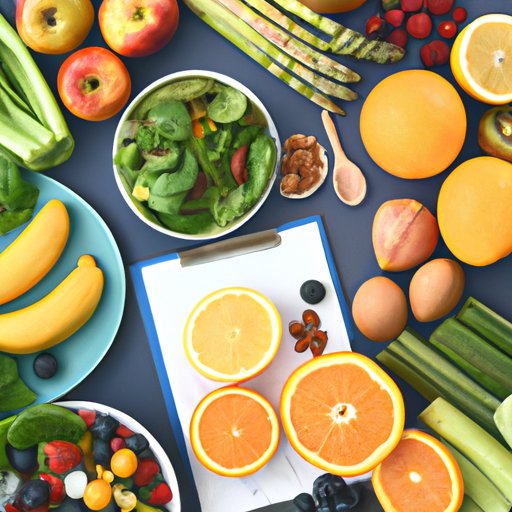
Introduction
A healthy diet is a crucial factor in maintaining overall health and well-being. It can reduce the risk of chronic diseases, boost energy levels, and improve mental clarity. A healthy diet also supports the immune system, promotes healthy weight management, and contributes to longevity. In this article, we will explore what a healthy diet looks like, providing helpful tips and tricks for those looking to establish a balanced and nutritious meal plan.
7 Components of a Healthy Diet, and Why Each One Matters
A healthy diet should consist of seven essential components, including carbohydrates, protein, healthy fats, vitamins, minerals, fiber, and water.
Carbohydrates are the primary source of energy for the body. They help regulate blood sugar levels and keep you feeling full and satisfied. Whole grains, fruits, and vegetables are excellent sources of complex carbohydrates.
Protein is essential for building and repairing muscle, supporting the immune system, and promoting healthy hormonal balance. Good sources of protein include lean meats, eggs, beans, and legumes.
Healthy fats are necessary for hormonal health, brain function, and healthy skin. Good sources of healthy fats include nuts, seeds, avocado, and fatty fish.
Vitamins and minerals are essential for overall health and cannot be produced by the body. A diet rich in fruits and vegetables is an excellent source of essential vitamins and minerals.
Fiber is essential for digestive health, weight management, and cholesterol reduction. Whole grains, fruits, and vegetables are all good sources of fiber.
Water is essential for maintaining proper hydration, promoting healthy digestion, and regulating body temperature.
The Ultimate Guide to Creating a Balanced and Nutritious Meal Plan
Creating a balanced and nutritious meal plan requires careful consideration of the seven essential components of a healthy diet. Begin by assessing your daily nutrient needs, and identify areas where you may need to increase or decrease consumption to achieve optimal health.
When creating your meal plan, focus on fresh, whole foods and avoid processed and high sugar items that are nutrient-poor. Incorporate a variety of fruits and vegetables, lean proteins, and healthy fats in every meal. Ensure that you are eating in portions appropriate for your nutritional needs and activity levels.
Eating Clean: Tips for Maintaining a Healthy Diet
Eating clean is about consuming foods that are nutrient-dense, free of harmful chemicals, additives, and preservatives. Avoid processed foods and focus on organic, unprocessed whole foods whenever possible. Opt for plant-based eating, including whole grains, fruits, and vegetables and choose lean proteins. Eating clean is not a diet, but rather a lifestyle, and sustainable changes to eating habits should be made gradually for optimal results.
The Role of Macronutrients in a Well-Balanced Diet
The three macronutrients, carbohydrates, protein, and fats, are essential for overall health. A well-balanced diet should include all three of these macronutrients. Carbohydrates provide energy for the body, and protein and fats support brain function, hormone production, and cell repair.
According to the Dietary Guidelines for Americans, it’s recommended that adults should consume between 45-65% of their daily calories from carbohydrates, 10-35% from lean proteins, and 20-35% from healthy fats.
Simple Swaps: How to Upgrade Your Diet for Optimal Health
Simple substitutions and ingredient swaps can help make your meals healthier and more nutritious. Swap out refined carbohydrates like white bread and pasta for whole grain versions. Use avocado or hummus instead of butter or creamy dressings. Instead of snacking on chips or candy, opt for an apple with almond butter or a handful of nuts.
Small changes go a long way in promoting healthy eating and making mealtime enjoyable and sustainable.
The Importance of Colorful Eating: Incorporating More Fruits and Vegetables into Your Diet
Fruits and vegetables are essential for good health, providing vitamins, minerals, and fiber. According to the American Heart Association, adults should consume 4.5 cups of fruits and vegetables per day. Aim for a variety of colors in your meal plan. Fill your plate with greens, oranges, reds, and blues. Add color with berries, sweet potatoes, beets, spinach, and kale.
Breaking Down the Myths: What a Healthy Diet Really Looks Like
Myths surrounding healthy eating abound, but it’s important to dispel misinformation and provide accurate information on what a healthy diet truly looks like. A healthy diet is not about deprivation or calorie counting. It’s about making sustainable changes to your eating habits that support overall health and well-being.
Eliminating entire food groups or following fad diets that promise quick weight loss is not sustainable. Instead, focus on eating whole, nutrient-dense foods in reasonable portions that meet your daily nutrient needs.
Conclusion
Establishing a healthy diet is essential for maintaining optimal health and well-being. By incorporating the seven essential components of a healthy diet, creating a balanced and nutritious meal plan, and making simple swaps to upgrade your eating habits, you can experience the benefits of a healthy lifestyle. Remember, healthy eating is not about deprivation or following fad diets, but rather a balanced, sustainable approach to food and nourishment.





